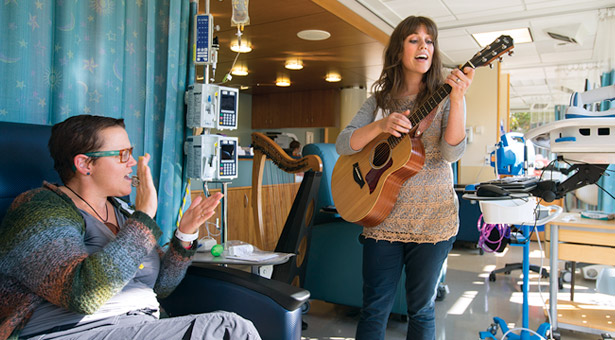The City Urban Perspectives
Harmony and Healing
Music Therapy Grad Brings Melodic Medicine to Patients
By Deanna Duff | Photo by Mike Siegel
 Betsy Hartman ’10 works with patients at
Swedish Cancer Institute every week. Here,
she (right) and patient Michelle Gherardi
sing John Denver's “Country Roads.”
Betsy Hartman ’10 works with patients at
Swedish Cancer Institute every week. Here,
she (right) and patient Michelle Gherardi
sing John Denver's “Country Roads.”
David Badley’s life was a symphony of music lessons and performance with a career in church and Hollywood music — until silence descended, after a 2014 diagnosis of stage 3 throat cancer.
To assist in recovery, Badley — now in his mid 50s and a patient at Swedish Cancer Institute — enrolled in music therapy with Betsy Hartman ’10.
“Betsy is like Mary Poppins. She brings a whole bag of music magic with her,” Badley says. “I could still barely talk or sing after treatment, but I asked her if we could just jam together. Sometimes I’d break down and cry. She prompted me to begin expressing myself again.”
Hartman, 28, is one of the first two board-certified graduates from Seattle Pacific University’s music therapy program, launched in 2008 and accredited by the American Music Therapy Association in 2009.
Hartman moved to southern California after graduating, then in 2014 moved back to Seattle to join the therapeutic play program at Seattle Children’s Hospital. On average, she treats a roster of 15–20 patients per week, ranging from infants to young adults. She now also owns PNW Music Therapy, a private practice, where she oversees music therapists who work in hospitals, retirement homes, and facilities for people with mental illnesses and intellectual disabilities.
For young children, the goal is often to provide an alternate focus through music while they experience difficult procedures such as IV pokes or blood draws.
With older children and adults, Hartman often teaches instrument lessons and, through those, coping skills. In addition to emotional expression, music therapy can enable rehabilitation goals. Beating a rhythm on a drum fosters endurance, functional motor skills, and strength training.
“Neurologic music therapy techniques are 100 percent quantifiable with science. Specific, measurable goals are addressed,” Hartman says. “However, sometimes people just want to play or hear music, and that’s equally valuable. People need to experience joy even when life is difficult.”
Modern music therapy traces its roots to World War II, when community musicians performed at hospitals for veterans. Today at SPU, students of the profession must be proficient in guitar, piano, and voice. They also receive specialized training in one of three areas: physical therapy and exercise science, psychology, or special education.
The major requires 120 hours of practicum work at one of Seattle Pacific’s dozen partner sites ranging from hospitals to homeless shelters. A six-month internship demands more than 1,000 hours of work at an accredited site.
Prospective students from across the nation regularly contact Carlene Brown, associate professor and chair of SPU’s Music Department and director of music therapy, with hopes of enrolling in the at-capacity program, the only one in Washington state. Student investment is part of what makes the program great, Brown says; Hartman, for instance, is a practicum advisor for the program and hires SPU graduates. (She currently has one SPU grad on contract and formerly worked with another.)
“Betsy was someone who immediately connected with the concept of what it means to serve others through music,” Brown says. “That connection is why music therapy fits SPU so well.”
Music therapy helped Badley find his voice again. Singing along with Hartman to “Somewhere Over the Rainbow” helped his physical recovery. It also restored a sense of joy that he attributes to an “underlying faith that I’m alive for a purpose.”
“Music can touch someone so much deeper than my words ever could,” Hartman says. “To offer that to people is incredibly meaningful work.”
